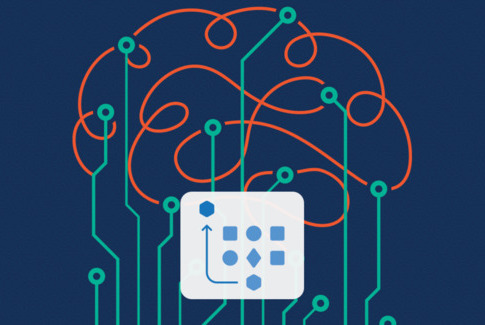
By nature, human language is complex. To understand human speech, a technology must understand the grammatical rules, meaning, and context, as well as colloquialisms, slang, and acronyms used in a language. Natural language processing (NLP) algorithms support computers by simulating the human ability to understand language data, including unstructured text data.
The 500 most used words in the English language have an average of 23 different meanings.
The Value of NLP
Language plays a role in nearly every aspect of business. As a result, we generate a staggering amount of unstructured data (e.g., PDFs, emails, videos, business documents, etc.). In fact, between 80% and 90% of enterprise data is unstructured. This data contains valuable information that can provide key business insight…but it needs NLP to unlock it.
According to a 2019 Deloitte survey, only 18% of companies reported being able to use their unstructured data. This emphasizes the level of difficulty involved in developing an intelligent language model. But while teaching machines how to understand written and spoken language is hard, it is the key to automating processes that are core to your business.
The level at which the machine can understand language is ultimately dependent on the approach you take to training your algorithm.
NLP Algorithms Explained
NLP algorithms can take many shapes depending on the artificial intelligence (AI) approach you take. Most commonly, companies will employ one of the three core approaches:
- Symbolic
- Statistical
- Hybrid (combination of the first two)
Symbolic Algorithms
Symbolic algorithms analyze the meaning of words in context and use this information to form relationships between concepts. This approach contrasts machine learning models which rely on statistical analysis instead of logic to make decisions about words.
Symbolic AI uses symbols to represent knowledge and relationships between concepts. It produces more accurate results by assigning meanings to words based on context and embedded knowledge to disambiguate language.
Knowledge graphs help define the concepts of a language as well as the relationships between those concepts so words can be understood in context. These explicit rules and connections enable you to build explainable AI models that offer both transparency and flexibility to change.
The single biggest downside to symbolic AI is the ability to scale your set of rules. Knowledge graphs can provide a great baseline of knowledge, but to expand upon existing rules or develop new, domain-specific rules, you need domain expertise. This expertise is often limited and by leveraging your subject matter experts, you are taking them away from their day-to-day work.
Statistical Algorithms
Statistical algorithms allow machines to read, understand, and derive meaning from human languages. Statistical NLP helps machines recognize patterns in large amounts of text. By finding these trends, a machine can develop its own understanding of human language.
In statistical NLP, this kind of analysis is used to predict which word is likely to follow another word in a sentence. It’s also used to determine whether two sentences should be considered similar enough for usages such as semantic search and question answering systems.
Statistical algorithms are easy to train on large data sets and work well in many tasks, such as speech recognition, machine translation, sentiment analysis, text suggestions, and parsing. The drawback of these statistical methods is that they rely heavily on feature engineering which is very complex and time-consuming.
Hybrid Algorithms
Hybrid algorithms use both statistical and symbolic approaches to leverage the strengths of each while minimizing their weaknesses. This can be used in a couple different ways:
- Symbolic supports machine learning
- Machine learning supports symbolic
- Symbolic and machine learning working in parallel
A good example of symbolic supporting machine learning is with feature enrichment. With a knowledge graph, you can help add or enrich your feature set so your model has less to learn on its own.
On the other hand, machine learning can help symbolic by creating an initial rule set through automated annotation of the data set. Experts can then review and approve the rule set rather than build it themselves.
Lastly, symbolic and machine learning can work together to ensure proper understanding of a passage. Where certain terms or monetary figures may repeat within a document, they could mean entirely different things. A hybrid workflow could have symbolic assign certain roles and characteristics to passages that are relayed to the machine learning model for context.
NLP Algorithms at Work
Today, we can see many examples of NLP algorithms in everyday life from machine translation to sentiment analysis. When applied correctly, these use cases can provide significant value.
Machine Translation
Machine translation uses computers to translate words, phrases and sentences from one language into another. It can help you quickly translate large amounts of text. For example, this can be beneficial if you are looking to translate a book or website into another language.
Machine translation can also help you understand the meaning of a document even if you cannot understand the language in which it was written. This automatic translation could be particularly effective if you are working with an international client and have files that need to be translated into your native tongue.
Automatic Summarization
Automatic summarization is the process of creating a short, actionable summary from a longer piece of text. This is commonly used to process large amounts of unstructured data (e.g., news articles, emails, business documents, etc.) and highlight the core information in each file. With this information, people can determine whether content is relevant and useful to them.
The challenge here is establishing context. For your model to provide a high level of accuracy, it must be able to identify the main idea from an article and determine which sentences are relevant to it. Your ability to disambiguate information will ultimately dictate the success of your automatic summarization initiatives.
Speech Recognition
Speech recognition converts spoken words into written or electronic text. Companies can use this to help improve customer service at call centers, dictate medical notes and much more.
The challenge is that the human speech mechanism is difficult to replicate using computers because of the complexity of the process. It involves several steps such as acoustic analysis, feature extraction and language modeling.
Symbolic, statistical or hybrid algorithms can support your speech recognition software. For instance, rules map out the sequence of words or phrases, neural networks detect speech patterns and together they provide a deep understanding of spoken language.
Text Classification
Text classification is the process of automatically categorizing text documents into one or more predefined categories. Text classification is commonly used in business and marketing to categorize email messages and web pages.
Each document is represented as a vector of words, where each word is represented by a feature vector consisting of its frequency and position in the document. The goal is to find the most appropriate category for each document using some distance measure.
Text classification can be used in a variety of ways. For instance, it can be used to classify a sentence as positive or negative. It can also predict which category a document belongs to. This can be useful for nearly any company across any industry.
Named Entity Recognition/Extraction
Named entity recognition/extraction aims to extract entities such as people, places, organizations from text. This is useful for applications such as information retrieval, question answering and summarization, among other areas.
NER systems are typically trained on manually annotated texts so that they can learn the language-specific patterns for each type of named entity. However, this can be automated in a couple different ways.
The most reliable method is using a knowledge graph to identify entities. With existing knowledge and established connections between entities, you can extract information with a high degree of accuracy. Other common approaches include supervised machine learning methods such as logistic regression or support vector machines as well as unsupervised methods such as neural networks and clustering algorithms.
Sentiment Analysis
Sentiment analysis is the process of identifying, extracting and categorizing opinions expressed in a piece of text. It can be used in media monitoring, customer service, and market research. The goal of sentiment analysis is to determine whether a given piece of text (e.g., an article or review) is positive, negative or neutral in tone. This is often referred to as sentiment classification or opinion mining.
Sentiment analysis can be performed on any unstructured text data from comments on your website to reviews on your product pages. It can be used to determine the voice of your customer and to identify areas for improvement. It can also be used for customer service purposes such as detecting negative feedback about an issue so it can be resolved quickly.
Which NLP Algorithm Is Right for You?
The expert.ai Platform leverages a hybrid approach to NLP that enables companies to address their language needs across all industries and use cases. There may be no one-size-fits-all approach to building your natural language model, but by combining rule-based and statistical algorithms in a single platform, you have the tools at your disposal to tackle any challenge of any complexity.
Build a model that not only works for you now but in the future as well. You have no time to waste. See what you can accomplish with the expert.ai Platform.


